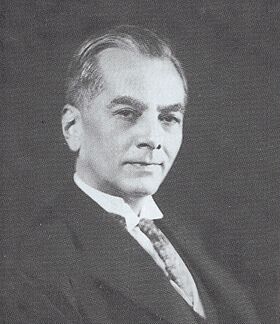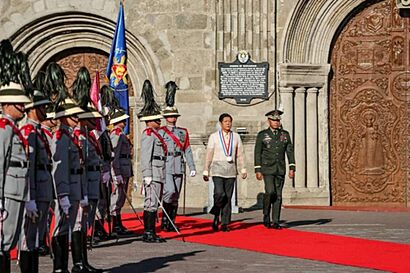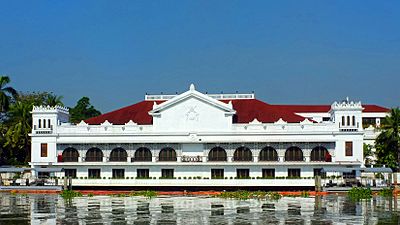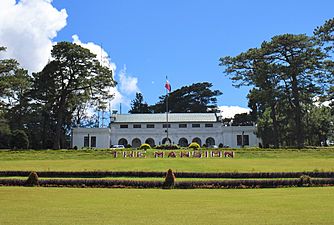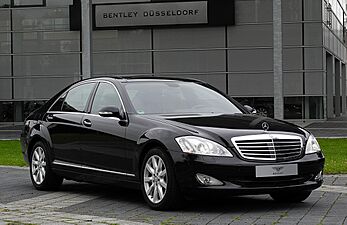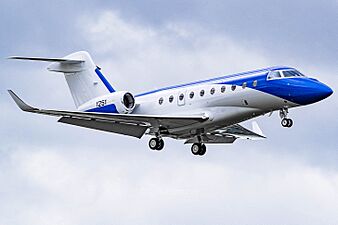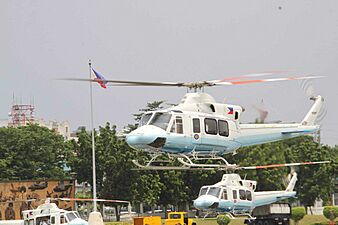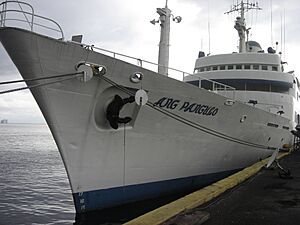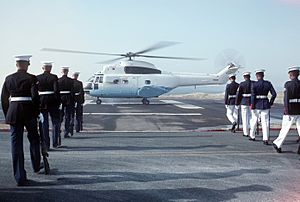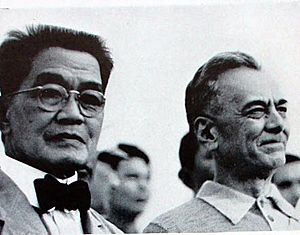President of the Philippines facts for kids
Quick facts for kids President of the Philippines |
|
|---|---|
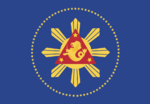
Presidential standard
|
|

Presidential seal
|
|
| Government of the Philippines Office of the President |
|
| Style |
|
| Member of | Cabinet National Security Council |
| Residence | Malacañang Palace |
| Seat | San Miguel, Manila, Philippines |
| Appointer | Direct popular vote or by succession from vice presidency |
| Term length | Six years,
non renewable
|
| Constituting instrument | Constitution of the Philippines (1987) |
| Precursor | Governor-General Prime Minister |
| Inaugural holder | Emilio Aguinaldo (official) Manuel L. Quezon (official) |
| Formation | 23 January 1899 (Republic; official) 15 November 1935 (Commonwealth; official) |
| First holder | Emilio Aguinaldo |
| Salary | ₱411,382/US$ 7,409 per month |
| Website | president.gov.ph (former website) |
The President of the Philippines (called Pangulo ng Pilipinas in Filipino) is the top leader of the Philippines. This person is the head of state (the country's main representative), the head of government (who runs the government), and the commander-in-chief of the Armed Forces of the Philippines.
Filipinos directly vote for their president. The president serves a single six-year term and cannot be re-elected. Sometimes, a vice president becomes president if the elected president leaves office early due to death or resignation.
The current president is Bongbong Marcos. He took office on June 30, 2022, at the National Museum of Fine Arts.
Contents
Presidential Titles
The official name for the leader of the Philippines is "President of the Philippines." In the Filipino language, the title is Pangulo, which means "leader" or "chieftain." In other Philippine languages, people often use presidente.
People often address the president as "Your Excellency" or "His/Her Excellency." However, some presidents, like Rodrigo Duterte, chose not to use this formal title in their official communications.
Past Presidential Titles
During the Japanese occupation of the Philippines, the leader was called "President of the Republic of the Philippines." This helped tell the difference between the government led by José P. Laurel and the Commonwealth government that was in exile. After World War II, the title "President of the Philippines" was used again.
History of Philippine Presidents
Early Republics and Leaders
Andrés Bonifacio's Role
Andrés Bonifacio was a key leader who started a revolution against Spanish rule in 1896. He was called the "Supreme President" (Kataas-taasang Pangulo) of the Katipunan, a secret revolutionary group. He also led a government known as the Tagalog Republic.
Some historians believe Bonifacio should be recognized as the first Philippine president. However, the current government officially recognizes Emilio Aguinaldo as the first president.
Aguinaldo's Leadership and the First Republic
In March 1897, Emilio Aguinaldo was elected president of a new revolutionary government. He was elected again in November at Biak-na-Bato. After the Spanish–American War began, Aguinaldo returned to the Philippines and declared independence on June 12, 1898.
On January 23, 1899, Aguinaldo became president of the "First Philippine Republic" (also called the Malolos Republic). This government had its own constitution. Even though this republic was short-lived and not recognized by other countries, the Philippine government today officially considers Aguinaldo the first president.
Other Claimants to the Presidency
Some scholars consider Miguel Malvar and Macario Sakay as "unofficial presidents" because they continued the fight for independence after Aguinaldo's capture. However, the government does not officially recognize them as presidents.
American Rule
From 1898 to 1935, the Philippines was under American control. The highest leaders during this time were American governors-general.
The Philippine Commonwealth
In October 1935, Manuel L. Quezon was elected the first president of the Commonwealth of the Philippines. This government was still under the United States. Quezon's term was originally six years, but it was later changed to two four-year terms.
During World War II, when Japan invaded, President Quezon went to the United States to set up a government in exile.
The Second Republic under Japan
On October 14, 1943, José P. Laurel became president under a constitution put in place by the Japanese occupation. Laurel was told by President Quezon to stay in Manila. Laurel dissolved this republic on August 17, 1945, after Japan surrendered.
After World War II
After World War II, the 1935 Constitution was brought back. Sergio Osmeña became president because Quezon had passed away. On July 4, 1946, the United States recognized the Philippines as an independent nation. Manuel A. Roxas, the last president of the Commonwealth, became the first president of the independent Republic of the Philippines.
Modern Constitutions
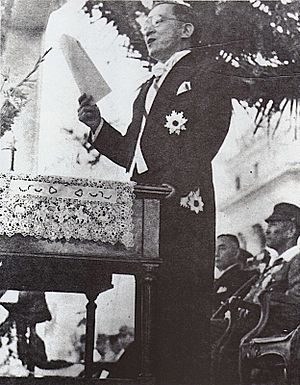
A new Constitution was approved in 1973 under Ferdinand Marcos. This constitution created a parliamentary-style government. Marcos served as both president and prime minister.
In 1986, the People Power Revolution ended Marcos's rule. Corazon C. Aquino became president. She put in place a "freedom constitution" that replaced the 1973 Constitution. This provisional constitution helped the country return to democratic rule. The current Constitution was put into effect on February 2, 1987.
The government considers Emilio Aguinaldo the first president, followed by Quezon and all later presidents. For example, Bongbong Marcos is considered the 17th president.
Presidential Powers and Roles
Executive Power
The president of the Philippines is the chief executive. This means they lead the government's executive branch, including the Cabinet and all government departments. The president also oversees local government units.
The president can issue executive orders, which help guide government policies. They can also grant pardons and reduce sentences for convicted people, except in impeachment cases. With Congress's approval, the president can grant amnesty.
The president can also make foreign loan agreements for the country, with approval from the Monetary Board. They have the power to take private property for public use, but fair payment must be given.
With the Commission on Appointments' consent, the president appoints heads of government departments, ambassadors, and high-ranking military officers. They also appoint members of the Supreme Court from a list provided by the Judicial and Bar Council.
Legislative Power
While Congress makes laws, the president has some power in this process. The president can veto (reject) any bill passed by Congress. If the president doesn't sign or veto a bill within 30 days, it automatically becomes law. Congress can override a presidential veto with a two-thirds vote from both houses.
The president can also veto specific parts of spending or tax bills. Through their influence, the president can help shape new laws. The annual State of the Nation Address is a chance for the president to share their plans for new laws.
Election Process
Who Can Be President?
To become president, a person must:
- Be a natural-born citizen of the Philippines.
- Be a registered voter.
- Be able to read and write.
- Be at least 40 years old on election day.
- Have lived in the Philippines for at least 10 years before the election.
A president can only serve one six-year term and cannot be re-elected. If someone becomes president because of succession and serves for more than four years, they cannot run for president again.
How the President is Elected
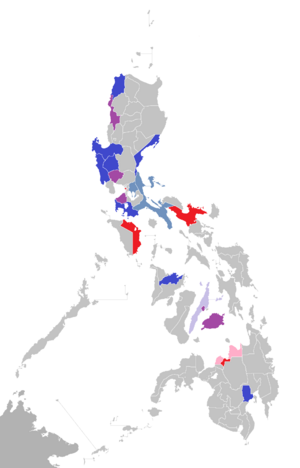
The president is elected by direct vote every six years, usually on the second Monday of May. The most recent election was in 2022.
After the election, the votes are counted and sent to Congress. The president of the Senate opens the vote certificates in a joint session of Congress. The person with the most votes wins. If there's a tie, Congress votes to choose the president.
Inauguration Ceremony
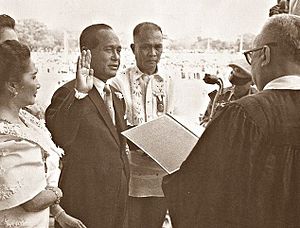
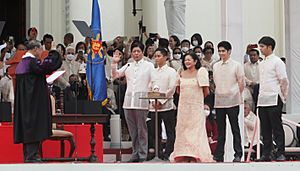
The president usually takes the oath of office at noon on June 30 after the election. The vice president usually takes the oath first.
Traditional places for the inauguration include Barasoain Church, the old Legislative Building, or Quirino Grandstand. Some presidents have chosen different locations. For example, Gloria Macapagal Arroyo took her oath in Cebu City in 2004.
People attending the ceremony usually wear traditional Filipino clothing, like the baro't saya for women and the barong tagalog for men.
The president takes an oath to faithfully fulfill their duties, protect the Constitution, enforce laws, be fair, and serve the nation. After the oath, a 21-gun salute is fired, and the presidential anthem "We Say Mabuhay" is played. The president then gives their inaugural speech and goes to Malacañang Palace.
Presidential Term and Succession
State of the Nation Address
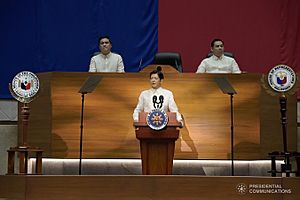
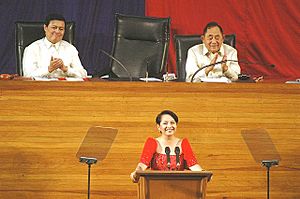
The State of the Nation Address (SONA) is an annual event. The president reports to Congress on the country's situation and their plans for the future.
Term Limits
The 1935 Constitution first set the president's term at six years, with no re-election. Later, it was changed to two four-year terms. Only Manuel L. Quezon and Ferdinand E. Marcos were re-elected under this rule. Marcos was the only president to serve three terms.
The 1987 Constitution brought back the ban on presidential re-election. The president's term starts at noon on June 30 after the election and lasts for six years. The president cannot be re-elected, even if their terms are not consecutive.
Vacancies and Succession
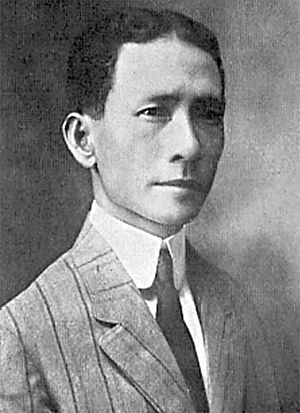
If the president cannot serve, the line of succession is:
- The Vice President
- The President of the Senate
- The Speaker of the House of Representatives
If both the president and vice president cannot serve, Congress will call for a special election.
Impeachment Process
Impeachment is a process to remove a president or other high-ranking officials from office for serious offenses. The House of Representatives starts the impeachment process. If one-third of its members agree, the case goes to the Senate of the Philippines.
The Senate acts as a court, with senators as judges. To remove the president, at least two-thirds of the senators must vote for conviction. If an impeachment attempt fails, no new cases can be filed against that official for one year.
Reasons for impeachment include serious violations of the Constitution, treason, bribery, corruption, other high crimes, and betrayal of public trust.
Official Residences
- Presidential residences
-
Malacañang Palace, the official residence
Malacañang Palace is the official home of the president in San Miguel, Manila. Its name comes from a Filipino phrase meaning "there is a nobleman there." The palace includes several buildings with traditional and classical designs.
Before Malacañang, Spanish governors-general lived in the Palacio del Gobernador. After an earthquake, they moved to Malacañang. During the Japanese occupation, the presidential office moved to The Mansion in Baguio.
The president also has other official residences. The Mansion in Baguio is the official summer palace. Malacañang of the South in Davao City is the president's residence in Mindanao. There are also other former official residences like Malacañang sa Sugbo in Cebu City and Malacañang of the North in the Ilocos Region.
Presidential Travel
- Philippine Presidential transportation
Air Travel
The 250th (Presidential) Airlift Wing of the Philippine Air Force provides air transport for the president and their family. They use planes like a Fokker F28 (called "Kalayaan One" when the president is on board) and helicopters like Bell 412s. For international trips, they use a Bombardier Global Express or charter planes from Philippine Airlines.
Water Travel
The BRP Ang Pangulo is the presidential yacht. It was built by Japan as part of World War II reparations. The president uses it to entertain guests.
Land Travel
The president uses two black, armored Mercedes-Benz W221 S600 Guard cars, with one acting as a decoy. The Presidential Security Group (PSG) escorts the president using SUVs like Toyota Fortuners and other vehicles. The presidential cars have a special license plate that says "1" or "PANGULO."
Many different cars have been used by presidents over the years, from a 1937 Chrysler Airflow for Manuel L. Quezon to modern Toyota Land Cruisers and Cadillac Escalade ESVs.
Presidential Security
The Presidential Security Group (PSG) is in charge of protecting the president, vice president, and their immediate families. They also protect visiting leaders from other countries. Former presidents and their families also receive a small security detail from the PSG.
List of Presidents
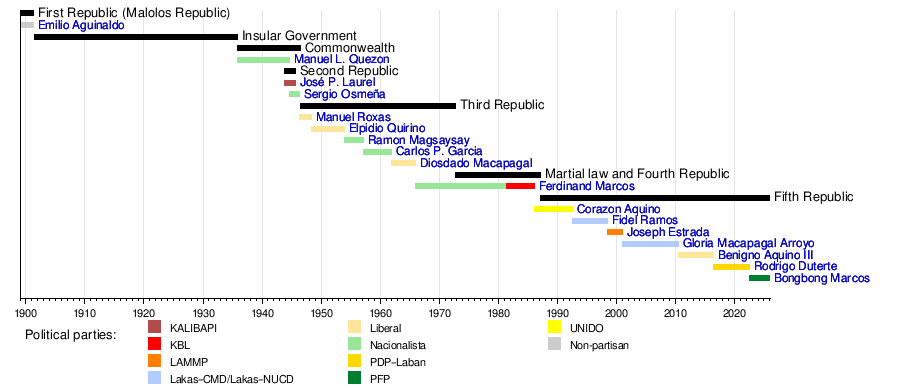
After the Presidency
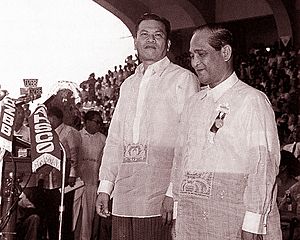
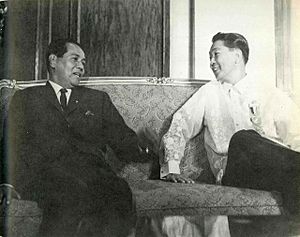
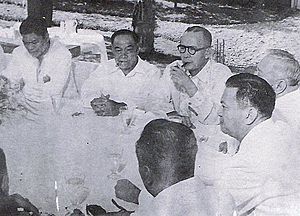
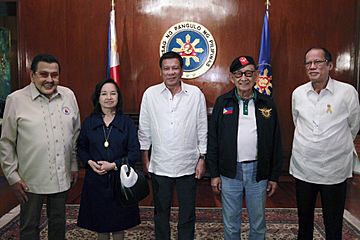
After leaving office, many former presidents continue to be involved in public life. They often hold other government positions or work on special projects. For example, former presidents and their immediate families are entitled to a security detail of seven soldiers.
- José P. Laurel became a senator and helped negotiate trade agreements with the United States.
- Sergio Osmeña and Elpidio Quirino served as councilors of state.
- Carlos P. Garcia and Diosdado Macapagal both became presidents of the Constitutional Convention.
- Corazon Aquino was a member of the National Security Council.
- Fidel Ramos founded a peace and development foundation and served as a special envoy to China.
- Joseph Estrada returned to acting and later became the Mayor of Manila.
- Gloria Macapagal Arroyo was elected to the House of Representatives of the Philippines and later became the House Speaker, the first woman to hold that position.
- Benigno Aquino III became a councilor of state.
- Rodrigo Duterte was a member of the National Security Council.
See also
 In Spanish: Presidente de Filipinas para niños
In Spanish: Presidente de Filipinas para niños
- First ladies and gentlemen of the Philippines
- Spouse of the president of the Philippines
- Prime Minister of the Philippines
- Seal of the president of the Philippines
- Languages spoken by presidents of the Philippines
- List of unofficial presidents of the Philippines
- Vice President of the Philippines
- Filipino styles and honorifics
- Heads of state and government of the Philippines
- List of people pardoned or granted clemency by the president of the Philippines
- List of sovereign state leaders in the Philippines
- List of recorded datu in the Philippines
- Governor-General of the Philippines
- Principalía
- Malacañang Palace
- "We Say Mabuhay"



